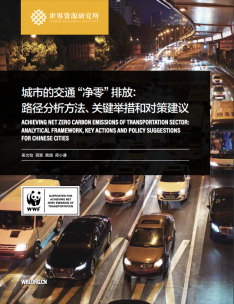Achieving Net Zero Carbon Emission of Transportation Sector: Analytical Framework, Key Actions and Policy Suggestions for Chinese Cities

The global greenhouse gas (GHG) emissions need to reach net-zero as soon as possible in order to achieve the Paris Agreement’s long-term temperature goal. Cities contribute to 70% of global GHG emissions, and its transportation sector will show the fastest growth in GHG emissions. Therefore, to fully support the global efforts to combat climate change, cities should begin by identifying its transportation sector’s emission pathways, and then implement emission reduction policies and measures, to achieve net-zero emissions in the transportation sector. This paper extracts common methodology in the analysis of transportation emission pathways and proposes key measures for achieving the net-zero emissions in the transportation sector, to provide reference information for Chinese cities to conduct similar research and formulate policies on low-carbon transportation.
Executive Summary
In the process of urbanization and the upgrading of economic structures, the transportation sector will show the fastest growth in greenhouse gas emissions. The pressure of climate change, air pollution and urban congestion should be sufficient reason to push cities to achieve net-zero emissions of greenhouse gases in the transportation sector as outlined in the Paris Agreement.
Cities should begin by setting up refined systems to calculate carbon emissions and researching pathway analysis options. Referencing the experiences of several cities in developing emission pathways, this paper outlines research methodology and provides specific suggestions for scenario and parameter settings for other cities to reference.
To better assist cities to analyze net-zero emissions in the transportation sector, this paper identifies the contribution of major energy saving and emissions reduction policies and measures in the transportation sector working toward the goal of net-zero emissions. Policies and measures with the highest potential for reducing emissions include the adoption of new energy sources, multimodal freight transport, energy-saving technologies and improved fuel quality. Measures such as new energy sources and improved fuel quality require industry-wide technological breakthroughs and policy supports. This study finds that industry-led policies have greater potential in reducing emissions than local government-led policies.
Despite the challenges faced by the transportation sector in achieving net-zero emissions, in the short-term cities can start by improving energy efficiency in all modes of transport and upgrading urban and intercity transportation structure. In the mid- and long-term, cities should vigorously promote the electrification of vehicles and work on developing zero-emission fuel for long-distance transportation. At the same time, cities should implement carbon removal measures to achieve net-zero emissions in transportation sector.
Projects

Sustainable Mobility
Visit ProjectSustainable Mobility Project aims to contribute to the development of low-carbon transportation in China, and build a green, efficient, inclusive and resilient urban mobility system.
Part of Sustainable Cities
Low-carbon transport
Visit ProjectWe work with national and local partners to develop medium- and long-term transport decarbonization roadmaps, formulate near-term key emission-reduction solutions, and facilitate global knowledge sharing, to achieve the low-carbon transition of China’s transport sector while ensuring social equit
Part of Sustainable Cities
